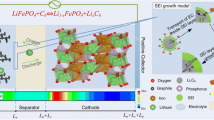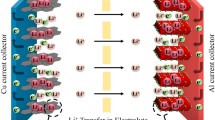Abstract
The transportation characteristics of Li+ in the active materials significantly affect the life and overall performance of lithium-ion cells. Analyzing the relationship between electrode thickness and heat/mass-related characteristics is thus very important for lithium-ion cells. The objective of this study was to investigate the effect of electrode thickness on the cell performance by developing a precise one-dimensional electrochemical–thermal coupled model with experimental validation. The thermal and heat-generation characteristics were investigated firstly. Then, the effects of the electrode thickness on the short-term and long-term electrochemical performance of lithium-ion cells were also explored experimentally and numerically from the perspectives of Li+ transport characteristics and discharging behaviors. The results indicated that the electrode thickness had a significant influence on the cell performance. Firstly, the cell with a thicker electrode showed a lower voltage plateau and an earlier stopping of the discharging process compared with the cell with a thinner electrode during a single discharging test; meanwhile, the cell with a thicker electrode presented a faster capacity degradation rate in the long-term cyclic tests. These influences were explained through the Li+ transportation mechanism and the electrochemical–thermal coupled effect.











Similar content being viewed by others
References
An Z, Jia L, Ding Y, Dang C, Li X (2017) A review on lithium-ion power battery thermal management technologies and thermal safety. J Therm Sci 26:391–412
Men X, Kong X, Yang X, Wang B, Wang Y, Liu Y, Yu L, Li H, Xu B (2020) Synthesis of a pomegranate shaped reduced graphene oxide stabilized secondary Si nanoparticles composite anode for lithium ion batteries. Int J Hydrogen Energy 45:29492–29504
Liao Q, Mu M, Zhao S, Zhang L, Jiang T, Ye J, Shen X, Zhou G (2017) Performance assessment and classification of retired lithium ion battery from electric vehicles for energy storage. Int J Hydrogen Energy 42:18817–18823
Sakti A, Michalek JJ, Fuchs ERH, Whitacre JF (2015) A techno-economic analysis and optimization of Li-ion batteries for light-duty passenger vehicle electrification. J Power Sources 273:966–980
Nam W, Kim J-Y, Oh K-Y (2018) The characterization of dynamic behavior of Li-ion battery packs for enhanced design and states identification. Energy Convers Manage 162:264–275
Xu M, Reichman B, Wang X (2019) Modeling the effect of electrode thickness on the performance of lithium-ion batteries with experimental validation. Energy 186:115864
Zheng H, Li J, Song X, Liu G, Battaglia VS (2012) A comprehensive understanding of electrode thickness effects on the electrochemical performances of Li-ion battery cathodes. Electrochim Acta 71:258–265
Hamankiewicz B, Michalska M, Krajewski M, Ziolkowska D, Lipinska L, Korona K, Kaminska M, Czerwinski A (2014) The effect of electrode thickness on electrochemical performance of LiMn2O4 cathode synthesized by modified sol–gel method. Solid State Ionics 262:9–13
Thunman M, Marquardt K, Hahn R, Kober D, Goerke O, Schubert H (2012) Discharge performance dependence on electrode thickness for Li4Ti5O12LiMn2O4 cells for application in wafer-integrated microbatteries. ECS Trans 41:147–157
An Z, Jia L, Wei L, Dang C, Peng Q (2018) Investigation on lithium-ion battery electrochemical and thermal characteristic based on electrochemical-thermal coupled model. Appl Therm Eng 137:792–807
Zhang J, Lu B, Song Y, Ji X (2012) Diffusion induced stress in layered Li-ion battery electrode plates. J Power Sources 209:220–227
Song Y, Lu B, Ji X, Zhang J (2012) Diffusion induced stresses in cylindrical lithium-ion batteries: analytical solutions and design insights. J Electrochem Soc 159:A2060–A2068
Jaguemont J, Boulon L, Dubé Y (2016) A comprehensive review of lithium-ion batteries used in hybrid and electric vehicles at cold temperatures. Appl Energy 164:99–114
Xiong R, Li L, Li Z, Yu Q, Mu H (2018) An electrochemical model based degradation state identification method of Lithium-ion battery for all-climate electric vehicles application. Appl Energy 219:264–275
Xuefei H, Yingxia H, Huanxin L (2019) Electrochemical-thermal coupled investigation of lithium iron phosphate cell performances under air-cooled conditions. Appl Therm Eng 147:907–916
Jiang G, Zhuang L, Hu Q, Liu Z, Huang J (2020) An investigation of heat transfer and capacity fade in a prismatic Li-ion battery based on an electrochemical-thermal coupling model. Applied Thermal Engineering 171:115080
Tan M, Gan Y, Liang J, He L, Li Y, Song S, Shi Y (2020) Effect of initial temperature on electrochemical and thermal characteristics of a lithium-ion battery during charging process. Applied Thermal Engineering 177:115500
Mei W, Chen H, Sun J, Wang Q (2019) The effect of electrode design parameters on battery performance and optimization of electrode thickness based on the electrochemical–thermal coupling model, Sustainable. Energy Fuels 3:148–165
Newman J, Tiedemann W (1975) Porous electrode theory with battery application. AIChE J 21:25–41
Rao L, Newman J (1997) Heat-Generation rate and general energy balance for insertion battery systems. J Electrochem Soc 144:2697–2704
An Z, Jia L, Wei L, Yang C (2018) Numerical modeling and analysis of thermal behavior and Li+ transport characteristic in lithium-ion battery. Int J Heat Mass Transf 127:1351–1366
Jiang F, Peng P, Sun Y (2013) Thermal analyses of LiFePO4/graphite battery discharge processes. J Power Sources 243:181–194
Du S, Lai Y, Ai L, Ai L, Cheng Y, Tang Y, Jia M (2017) An investigation of irreversible heat generation in lithium ion batteries based on a thermo-electrochemical coupling method. Appl Therm Eng 121:501–510
Zhao R, Liu J, Gu J (2015) The effects of electrode thickness on the electrochemical and thermal characteristics of lithium ion battery. Appl Energy 139:220–229
Xu M, Zhang Z, Wang X, Jia L, Yang L (2014) Two-dimensional electrochemical–thermal coupled modeling of cylindrical LiFePO4 batteries. J Power Sources 256:233–243
Huang X, Ke S, Lv H, Liu Y (2018) A dynamic capacity fading model with thermal evolution considering variable electrode thickness for lithium-ion batteries. Ionics 24:3439–3450
Ogihara N, Itou Y, Sasaki T, Takeuchi Y (2015) Impedance spectroscopy characterization of porous electrodes under different electrode thickness using a symmetric cell for high-performance lithium-ion batteries. The Journal of Physical Chemistry C 119:4612–4619
Harris SJ, Timmons A, Baker DR, Monroe C (2010) Direct in situ measurements of Li transport in Li-ion battery negative electrodes. Chem Phys Lett 485:265–274
Wu W, Wu W, Qiu X, Wang S (2019) Low-temperature reversible capacity loss and aging mechanism in lithium-ion batteries for different discharge profiles. Int J Energy Res 43:243–253
Wu W, Ma R, Liu J, Liu M, Wang W, Wang Q (2021) Impact of low temperature and charge profile on the aging of lithium-ion battery: non-invasive and post-mortem analysis. Int J Heat Mass Tran 170:121024
Lin C, Tang A, Mu H, Wang W, Wang C (2015) Aging mechanisms of electrode materials in lithium-ion batteries for electric vehicles. J Chem 2015:1–11
Li X, Fang Q, Li J, Wu H, Liu Y, Wen P (2015) Diffusion-induced stress and strain energy affected by dislocation mechanisms in a cylindrical nanoanode. Solid State Ionics 281:21–28
Li J, Fang Q, Liu F, Liu Y (2014) Analytical modeling of dislocation effect on diffusion induced stress in a cylindrical lithium ion battery electrode. J Power Sources 272:121–127
Valentin O, Thivel P-X, Kareemulla T, Cadiou F, Bultel Y (2017) Modeling of thermo-mechanical stresses in Li-ion battery. Journal of Energy Storage 13:184–192
An Z, Jia L, Li X, Ding Y (2017) Experimental investigation on lithium-ion battery thermal management based on flow boiling in mini-channel. Appl Therm Eng 117:534–543
Lei Z, Maotao Z, Xiaoming X, Donghai H, Jing W, Renzheng L, Jiaqi F (2018) Heat dissipation analysis of double-layer battery pack under coupling heat transfer of air, liquid, and solid. Int J Energy Res 42:4840–4852
Funding
This work was supported by the project of Natural Science Foundation of Gansu Province (Grant No. 20JR10RA193, Grant No. 18JR3RA141), National Natural Science Foundation of China (Grant No. 51806093), Doctoral Research Funds of Lanzhou University of Technology (Grant No. 061907).
Author information
Authors and Affiliations
Corresponding author
Additional information
Publisher's note
Springer Nature remains neutral with regard to jurisdictional claims in published maps and institutional affiliations.
Rights and permissions
About this article
Cite this article
An, Z., Zhao, Y., Shi, T. et al. Modeling and experimental analysis of the thermal and electrochemical characteristics of lithium-ion cells with different electrode thickness. Ionics 28, 719–732 (2022). https://doi.org/10.1007/s11581-021-04365-7
Received:
Revised:
Accepted:
Published:
Issue Date:
DOI: https://doi.org/10.1007/s11581-021-04365-7




